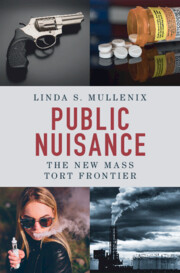Book contents
- Public Nuisance
- Public Nuisance
- Copyright page
- Dedication
- Contents
- Acknowledgements
- Introduction
- 1 Historical Context of Private and Public Nuisance at Law and Equity
- 2 Shifting Mass Tort Theories in the 1990s and the Judicial Resistance to the Expansion of Public Nuisance Liability
- 3 Expanding Public Nuisance Doctrine
- 4 Litigating Public Nuisance Claims
- 5 Expanding Public Nuisance Doctrine: Defenses
- 6 Expanding Public Nuisance
- 7 Environmental Contamination, PCBs, and Climate Change as Public Nuisance Harms
- 8 Opioids as Public Nuisance Health and Welfare Harm
- 9 Firearms Violence as a Public Nuisance
- 10 E-Cigarettes and Vaping as a Public Nuisance Harm
- 11 Evaluating the Competing Arguments Regarding the Contemporary Use of Public Nuisance in Mass Tort Litigation
- Conclusion
- Index
4 - Litigating Public Nuisance Claims
Burdens on Plaintiffs
Published online by Cambridge University Press: 02 November 2023
- Public Nuisance
- Public Nuisance
- Copyright page
- Dedication
- Contents
- Acknowledgements
- Introduction
- 1 Historical Context of Private and Public Nuisance at Law and Equity
- 2 Shifting Mass Tort Theories in the 1990s and the Judicial Resistance to the Expansion of Public Nuisance Liability
- 3 Expanding Public Nuisance Doctrine
- 4 Litigating Public Nuisance Claims
- 5 Expanding Public Nuisance Doctrine: Defenses
- 6 Expanding Public Nuisance
- 7 Environmental Contamination, PCBs, and Climate Change as Public Nuisance Harms
- 8 Opioids as Public Nuisance Health and Welfare Harm
- 9 Firearms Violence as a Public Nuisance
- 10 E-Cigarettes and Vaping as a Public Nuisance Harm
- 11 Evaluating the Competing Arguments Regarding the Contemporary Use of Public Nuisance in Mass Tort Litigation
- Conclusion
- Index
Summary
Chapter 4 turns to an elucidation of a plaintiffs pleading burden in alledging a public nuisance claim. In modern 20th century jurisprudence, as defined by the ALI Restatement (Second) of Torts, a public nuisance claim involves four elements that a plaintiff must prove: (1) the defendants affirmative conduct (2) caused an unreasonabel interference (3) with a right common to the general public (4) this is abatable. The ALI Restatement (Second) public nuisance elements are derived from the common law extant at the time of drafting the restatement. Many states have codified these elements, or similar elements, in thier general public nuisance statutes. This chpater examines the competing ways in which courts have interprtede these elemts, particularly what constitutes a commonly held publci rigt. Courts also have diagreed concerning what constitutes an unreasonable interference with a public right. The chapter concludes with an exploration of of the judicial trend towards greater flexibility in defining public nusiance more expansively than the common law doctrine and statutory interpretations.
- Type
- Chapter
- Information
- Public NuisanceThe New Mass Tort Frontier, pp. 71 - 89Publisher: Cambridge University PressPrint publication year: 2023

